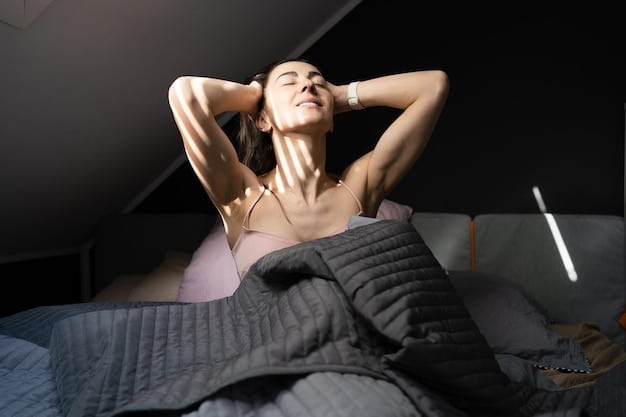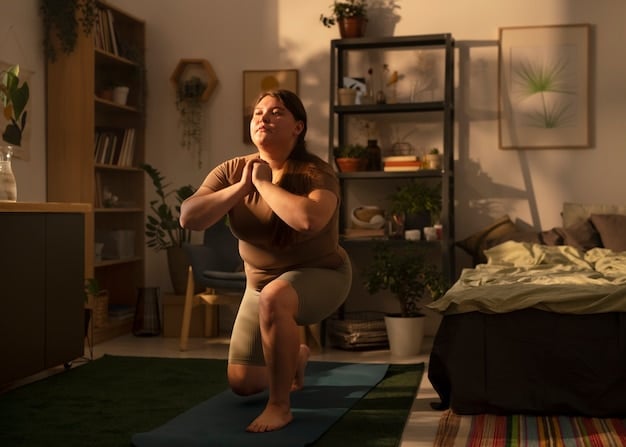Progressive Muscle Relaxation: Stress Reduction & Sleep Quality in US

Progressive Muscle Relaxation (PMR) is a stress-reduction technique involving tensing and relaxing muscle groups to relieve tension, enhance bodily awareness, and promote better sleep quality, especially beneficial in the US.
Do you find yourself tossing and turning at night, or constantly feeling overwhelmed by stress? Progressive Muscle Relaxation (PMR) offers a simple yet powerful technique to ease tension, improve sleep quality, and enhance overall well-being right here in the US.
What is Progressive Muscle Relaxation?
Progressive Muscle Relaxation (PMR) is a relaxation technique developed by American physician Edmund Jacobson in the 1920s. It involves systematically tensing and relaxing different muscle groups in the body.
The core principle behind PMR is the conscious awareness of the difference between tension and relaxation, enabling individuals to release physical tension and, consequently, reduce mental stress. This technique is widely used in the US to promote relaxation and improve sleep quality.
The Science Behind PMR
PMR works by tapping into the body’s natural relaxation response. When we experience stress, our muscles tend to tense up. By consciously tensing and then relaxing these muscles, we can reduce overall muscle tension and send signals to the brain to calm down.
Studies have shown that PMR can decrease levels of stress hormones like cortisol and adrenaline, while also increasing the production of endorphins, which have mood-boosting effects. This makes PMR a valuable tool for stress management and improving sleep.
- Reduces muscle tension: By consciously tensing and releasing muscles, you learn to identify and release physical tension.
- Lowers stress hormones: PMR has been shown to decrease cortisol and adrenaline levels.
- Increases endorphins: The relaxation response stimulated by PMR can boost endorphin production.
- Promotes a sense of calm: PMR helps shift the nervous system from a state of arousal to a state of relaxation.
In summary, Progressive Muscle Relaxation is a scientifically-backed technique that empowers individuals in the US to actively manage their stress levels and improve their sleep by understanding and controlling the body’s tension and relaxation responses.
Benefits of Progressive Muscle Relaxation
The benefits of Progressive Muscle Relaxation extend far beyond simply feeling relaxed. This technique can have a profound positive impact on various aspects of your physical and mental health, especially for individuals managing stress in the US.
Regular practice of PMR can lead to improved sleep quality, reduced anxiety, and enhanced overall well-being. Let’s explore some of the key benefits in more detail.
Improved Sleep Quality
One of the most significant benefits of PMR is its ability to improve sleep quality. By reducing muscle tension and promoting a sense of calm, PMR makes it easier to fall asleep and stay asleep throughout the night.
This is particularly helpful for individuals in the US who struggle with insomnia or other sleep disorders. A relaxed body and mind are much more conducive to restful sleep.
Reduced Anxiety and Stress
PMR is a highly effective tool for reducing anxiety and stress. By consciously releasing tension in the body, you can also release tension in the mind. This can lead to a significant decrease in feelings of worry, nervousness, and overall stress.

For those in the US dealing with daily stressors or anxiety disorders, PMR offers a natural and accessible way to manage these challenges.
- Decreased anxiety symptoms: Regular PMR practice can alleviate symptoms of generalized anxiety disorder and other anxiety-related conditions.
- Improved mood: By promoting relaxation and reducing stress hormones, PMR can contribute to a more positive mood.
- Enhanced coping skills: PMR equips individuals with a practical tool to manage stress in various situations.
In essence, practicing Progressive Muscle Relaxation regularly can yield improved sleep, diminished stress and anxiety, and better mental and physical well-being for individuals in the US.
How to Practice Progressive Muscle Relaxation
Practicing Progressive Muscle Relaxation is relatively straightforward and can be done virtually anywhere, making it a convenient stress-relief method accessible to anyone in the US. All you need is a quiet space and about 15-20 minutes of your time.
Here’s a step-by-step guide on how to perform PMR effectively.
Preparation
Before you begin, find a quiet and comfortable place where you won’t be disturbed. Lie down on a comfortable surface, such as a bed or yoga mat. You can also practice PMR while sitting in a comfortable chair.
Wear loose-fitting clothing and remove any distractions, such as your phone or other electronic devices. Take a few deep breaths to center yourself and prepare for the exercise.
The Technique
The basic principle of PMR is to tense a specific muscle group, hold the tension for a few seconds, and then release the tension, noticing the difference between the two states. Work through the major muscle groups in your body, following this sequence:
- Hands: Make a fist, squeezing tightly, and then release.
- Arms: Bend your elbows and tense your biceps, then release.
- Forehead: Raise your eyebrows as high as you can, then release.
- Eyes and Nose: Close your eyes tightly and wrinkle your nose, then release.
- Mouth and Jaw: Clench your teeth and pull back the corners of your mouth, then release.
- Neck: Press your head back into the surface you’re lying on, then release.
- Shoulders: Shrug your shoulders up towards your ears, then release.
- Back: Arch your back slightly off the surface, then release.
- Stomach: Tense your stomach muscles, then release.
- Hips and Buttocks: Squeeze your buttocks muscles, then release.
- Thighs: Tense your thigh muscles, then release.
- Calves: Point your toes and tense your calf muscles, then release.
- Feet: Curl your toes downwards, then release.
In conclusion, practicing PMR requires preparation and focus which will provide relief in the form of a stress-relaxation technique that can be performed by anyone in the US.
Tips for Effective Progressive Muscle Relaxation
While the basic technique of Progressive Muscle Relaxation is simple, there are several tips that can help you maximize its effectiveness and make it a more enjoyable experience for those practicing in the US.
Consistency, focus, and a few minor adjustments can make a significant difference in the benefits you receive from PMR.
Focus on the Sensation
As you tense and release each muscle group, pay close attention to the sensation. Notice the difference between the feeling of tension and the feeling of relaxation. This awareness is key to training your body to release tension more easily.
Try to avoid letting your mind wander. If you find yourself distracted, gently bring your attention back to the sensations in your body.
Breathe Deeply
Deep, slow breathing is an essential component of PMR. As you tense each muscle group, inhale deeply. As you release the tension, exhale slowly and completely. This helps to further promote relaxation and calm the nervous system.

Syncing your breath with the tensing and releasing of your muscles can enhance the relaxation response.
- Practice regularly: Consistency is key to experiencing the full benefits of PMR.
- Be patient: It may take some time to become fully comfortable with the technique.
- Adjust the tension: The amount of tension you apply to each muscle group should be moderate.
Ultimately, to promote effective PMR, it is essential to pay attention to the sensation of muscle relaxation, breathe deeply, and be consistent.
Integrating PMR Into Your Daily Routine
Integrating Progressive Muscle Relaxation into your daily routine can be easier than you might think, providing consistent stress relief for individuals in the US. Even just a few minutes of PMR each day can make a significant difference in your stress levels and overall well-being.
Here are some practical ways to incorporate this technique into your life.
Morning Relaxation
Start your day with a short PMR session to set a calm and focused tone. This can help you approach the day with a clearer mind and less stress. Before getting out of bed, spend 5-10 minutes practicing PMR, focusing on releasing any tension you may be holding in your body.
This can be a particularly effective way to counter the effects of a restless night and prepare yourself for the day ahead.
Midday Stress Relief
Take a break in the middle of the day to practice PMR as a way to de-stress and recharge. Find a quiet spot where you can sit comfortably, and spend 10-15 minutes going through the muscle groups. This can help you refocus and improve your productivity for the rest of the day.
This midday PMR session can be especially beneficial if you work in a high-stress environment or have a demanding job.
- Use PMR before bed: Practicing PMR before bed can improve sleep quality.
- Combine PMR with other relaxation techniques: Combining PMR with mindfulness or meditation.
- Use PMR during stressful situations: PMR can be used in the moment to manage stress during challenging situations.
In summary, PMR can be integrated into your everyday life by practicing in the morning, midday, or before bed to provide a sense of calm and stress relief that will benefit individuals in the US.
Additional Resources for Learning PMR
While this article provides a comprehensive overview of Progressive Muscle Relaxation, there are many additional resources available to help you deepen your understanding and refine your practice in the US.
Exploring these resources can provide you with guided exercises, further insights, and support to make PMR an even more effective tool for stress management and sleep improvement.
Books and Guides
Several books and guides offer detailed instructions and insights into PMR. These resources can provide a more in-depth understanding of the technique and offer variations to suit your individual needs.
Look for books written by experts in relaxation techniques and stress management. These can provide valuable guidance and support.
Online Videos and Audio
Numerous online videos and audio recordings can guide you through PMR exercises. These resources are often free and can be a convenient way to practice PMR at home or on the go.
Search platforms like YouTube and Spotify for guided PMR sessions. These can be particularly helpful if you’re new to the technique or prefer to have someone guide you through the exercises.
- Apps for PMR: Consider exploring mobile apps that offer guided PMR exercises and track your progress.
- Workshops and classes: Consider attending workshops or classes on PMR.
- Consult with a healthcare professional: A healthcare professional can provide personalized guidance.
To conclude, there are resources and tools to help those in the US master proper PMR techniques and skills for a better sense of well-being.
| Key Point | Brief Description |
|---|---|
| 💪 Muscle Tension | PMR helps you recognize and release muscle tension effectively. |
| 🌙 Sleep Quality | Regular PMR practice can lead to better sleep and reduced insomnia. |
| 🧘♀️ Daily Practice | Integrating PMR into your daily routine enhances well-being. |
| 🧠 Stress Reduction | PMR reduces stress hormones and promotes calmness. |
Frequently Asked Questions (FAQs)
▼
The best time to practice Progressive Muscle Relaxation depends on your schedule and preferences. Many people find it helpful to practice PMR before bed to improve sleep. Others prefer to practice it during the day as a stress-relief technique. Experiment with different times to find what works best for you.
▼
A typical PMR session lasts between 15 and 20 minutes. However, you can adjust the length of the session based on your needs and available time. Even a shorter 5-10 minute session can be beneficial. The key is to focus on the sensations in your body and breathe deeply to enhance relaxation.
▼
Yes, Progressive Muscle Relaxation can be a helpful tool for managing anxiety disorders. PMR helps to reduce muscle tension and promote a sense of calm, which can alleviate symptoms of anxiety. Regular practice of PMR can lead to a significant decrease in feelings of worry, nervousness, and overall stress.
▼
Progressive Muscle Relaxation is generally safe for most people. However, if you have any underlying medical conditions or physical limitations, it’s a good idea to consult with your healthcare provider before starting PMR. They can provide personalized guidance and ensure that it’s appropriate for your specific needs.
▼
The time it takes to see results from Progressive Muscle Relaxation varies from person to person. Some people may experience immediate relaxation and stress relief after their first session. For others, it may take a few weeks of regular practice to notice significant improvements in sleep quality and anxiety levels. Consistency is key.
Conclusion
Progressive Muscle Relaxation is a valuable technique readily available to those in the US that can help reduce stress and improve sleep quality. By systematically tensing and relaxing different muscle groups, individuals can learn to recognize and release physical tension, promoting a sense of calm and relaxation conducive to better sleep and stress management. With consistent practice, PMR can be a simple yet powerful tool for enhancing overall well-being.





